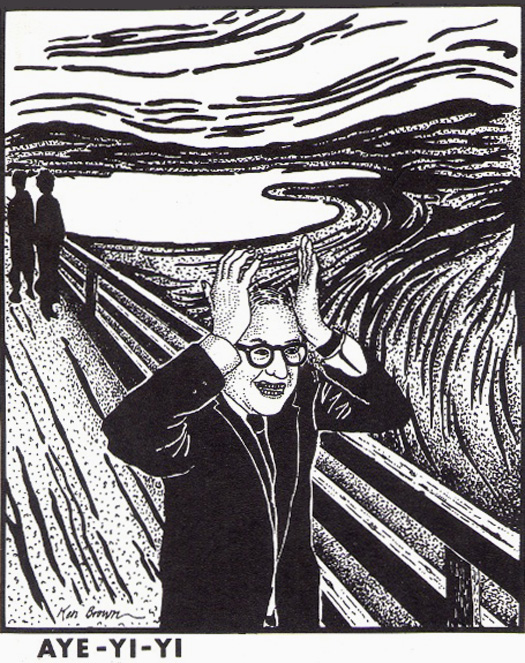
Postcard image by Ken Brown.
Since the beginning of professional industrial design — throughout the entire 20th century and into the first decade of the 21st — a designer has been a figure of confidence and authority. He (rarely, she) provided answers, solved problems, knew more than the public could possibly knew. A notion of an unsure designer, a questioning designer, or, heaven forbid, a doubtful designer would appear almost oxymoronic, and certainly unprofessional.
Perhaps the new decade will go down in history as marking the outset of Design Uncertainty. For the first time ever, designers are willing to question, openly and publicly, the nature of their profession and whether they are doing the right thing. This year, for the first time, an interrogation mark appeared in the title of the National Design Triennial at the Cooper-Hewitt. In the Netherlands, Eindhoven Design Academy’s 2010 exhibition in Milan expressed the same spirit of inquiry with an even more succinct title, a simple “?”
The reasons for self-searching and doubt are obvious, and they are not pretty. Two seemingly never-ending wars have contributed to political uncertainty and fueled fears of terrorism. The economic meltdown of 2008 continues to reverberate around the world. An unimpeded flood of oil gushes out in the Gulf of Mexico, in spite of the feats of the world’s best experts to stop it. Alice Rawsthorn, writing in The New York Times, recently captured the spirit of our time when she referred to design as “a quest for meaning in a dystopian era.” This existential mission, rather than a pursuit of new shapes, is going to define the design effort for years to come. And any search for meaning always starts with a question.
Clive Dilnot, a professor at The New School University, writes in an essay titled "Ethics? Design?" that the basis of any design activity derives from a fundamental query posed by Socrates: “How should one live?” According to Dilnot, this question cannot lead to a singular answer. Rather, the argument is brought up again and again by every new generation, leaving the ethical dimension of design “always in question, always in doubt."
It is not surprising that the best design schools are in the forefront of design’s quest for meaning. Unencumbered by market considerations, academia is well suited for experimentation, creative research and the production of ideas. It is good to be a student in times like these. But what about the teachers? The traditional role of all-knowing professor is rapidly changing. Instead, a teacher has become a fellow researcher, a team leader who works with the group in an interactive, collaborative way. The result is inevitably interdisciplinary: a design “product” could be an idea, a service, a material or a narrative, and it is viewed as a process rather than an artifact.
With these thoughts I start a new chapter in my professional life. Recently, I have become director of graduate design studies at the Virginia Commonwealth University in Qatar. All complexities and contradictions on the modern world are reflected in the microcosm of this Persian Gulf state: East and West, old and new, national and global, rich and poor. This is a world in transition, full of its own uncertainties. As such, it should be a great testing ground for new ideas and new solutions. A small group of young men and women from different design backgrounds are joining our program, the first of its kind in the entire Gulf Region. Let the experiment begin. Together, we will be trying to work out our own answers to that nagging question, Why Design Now?


Comments [9]
Over the last twelve years as a professional designer, I've noticed the same trends of which you write: design products are less and less about just making artifacts. Education must (and is) catching on that the goals are idea, concept and innovation, not just grids, color theory and kerning. I think this age of questioning design (and questioning designers) will lead to a more healthy and more robust design process, yielding innovative and unexpected results and solutions.
Here's looking forward to learning of your discoveries as you conduct research in the unique petrie dish of that area of the world.
07.12.10
12:33
I would like to share with you three examples. One from GDC (The Society of Graphic Designers of Canada) website, one from a discussion which a successful local designer Eric Karjaluoto started upon an interview Paula Scher gave recently, and the other one about what happened to a young teacher in Canada having questions and doubts about the education system. Please note that these examples may take a little bit of your time to go through but they are good, solid examples. To a world where we are not scared of questions and doubts! Thank you.
http://www.ideasonideas.com/2010/03/new-designers-and-the-moral-imperative/
http://www.gdc.net/education/index/articles85.php (just below Refine The Product/Business Skills)
http://www.vancouverobserver.com/contributors/myriam-dumont
07.12.10
01:47
The character of uncertainty today is the product of a deliberate program of perpetual flow and restructuring that facilitates compound capital accumulation. Design is not a victim in this, it is a willing, if indeed enchanted accomplice. Practitioners are right to experience an unsettling moral void. However we should not be so hasty to retreat from this disturbance. For design to become a robust force for change, designers and educators must become driven by a far deeper anxiety.
We live in violent times, but as Zizek has argued, it is not the violence of explicit and horrific events that should form the object of our concern. In design terms this just generates more awareness campaigns and disaster relief shelters. Rather, it is systemic violence that should unnerve us: "the often catastrophic consequences of the smooth functioning of our economic and political systems", an invisible violence inherent to the normal state of things, which can also be read as the normal state of designing things.
Design innovation has become so fetishised that we must cease to valorise it until it has been thoroughly reconstituted in alternative practice. To emphasise, that is in practice, i.e., as a product of engaged work that strives to secure spaces of stability and resistance.
Designers must have their anxieties stoked, not soothed. In order that design become a redemptive influence, designers must learn how disturbing our 'common sense' is, and be taught how to use this as a driver towards critical action.
07.12.10
09:17
To fret about Design and its turgid (and endless) question marks is to fret about a doubting monologue on the World Wrestling Federation: yes, perhaps wrestling is experiencing a crisis in confidence, and yes, perhaps the latest version of Steve Austin is reaching out to his fans for support/sympathy, but lets not kid ourselves about the social aims of these activities: the tools who think there's a bottom line other than profit distribution to the equity stakeholders are the saddest of this sad lot.
Why Design Now from a "Virginia" school in Qatar? Why have a cage match in Tokyo? Why have a USO event in Afgahnistan?
Lets not be squeemish about questions of force, power and victory - designers are pawns in that struggle, and if a Va school is opening a branch in Qatar, designers could happily follow the market share to understand the reasons - and if a question mark helps sell that soap in the face of Asian, Indian, and Arabic traditions, well, dammit, look for a lot of ????
07.15.10
10:30
07.16.10
09:29
If, by "for the first time ever," you mean "prominently since at least the early 1990s, and in some corners before then," this article is accurate. The author's attitude continues to plague design discussions: that of a phenomenon's non-existence until the writer notices it—or it's given credence through promulgation by "the best design schools" and/or design celebrities. There's already been (and is) a lot of questioning and experimenting going on—if you look beyond the immediate field and moment.
07.17.10
07:14
For that matter why not stay in Virginia. You might find some challenges there that demand more than further questions.
07.21.10
12:22
All too often design is given the credit for the manner in which things have been created. The faulty reasoning goes something like: the thing exists and therefore must have been been created, it has form and is configured in a distinct manner and therefore the thing must have been designed. And further, therefore it is a designed thing, regardless of whether or not a designer was involved. This reasoning stands for a view of not only designed things but also for all created things and has been adopted at the absurd end of the scale by movements such as the 'Intelligent Design' division of Creationism.
Most of the material generated for created things does not require design, nor does it need to be designed in order to exist in a particular form or arranged in a distinct manner. It is only when issues of form and configuration of elements is specifically required that design has a role to play. And then, to add a more refined semantic view of design it only really makes sense to talk of design when a designer has been actively involved, with a further contextual emphasis on a particular commercial arrangement ie. when a designer has been specifically employed to add value to a product. Jonathan Ive and Dieter Rams are good examples of designers in such a design-oriented relationship to commercial products.
It is also useful to think of design as concerning two types of activity, as follows:
1. As literal and physical form-giving design has the most value. This is the case when literal form-giving is required to add value to material. Material that does not require specialist technical knowledge of the materials or processes involved, and where 'softer' human requirements of ergonomics and usability are brought to bear on a solution, particularly when aesthetic or artistic values are important.
2. Design as an activity concerned with how things are configured is of secondary relevance. This is a weaker version of what people normally hold as design. It is with this interpretation that boundaries of design blur even further. This version refers to how the material of a thing has been arranged, where no literal or physical form-giving is required. This is particularly the case in the absence of aesthetic considerations. In such a situation even non-designers talk of designing 'things' such as oil refineries, microscopes or aircraft but this is a weak description of design. Engineers may talk of designing things but when pressed the objects have been 'engineered' and this is normally as a result of specialist technical knowledge in service of a particular problem. Architects may talk of designing buildings but they do not call themselves designers.
So, it should come as no surprise that people have become weary of what design can deliver. Or, that designers appear uncertain in the face of so many creative possibilities, and when specialist knowledge is increasingly a basic requirement to make a product commercially viable.
Design has been useful as a general creative term in recent history. Design is now seen to have very particular limitations. Design is not the saviour of the world, contrary to popular belief among designers. Were we to press even harder with this kind of reasoning we may find that design is not even as valuable as I've indicated above but it seems to me that design has sufficient value in the world not to cause it to fail completely.
We do not live in a time of uncertainty but we have moved into an age that understands that all certainty is reflexively false and that paradox has a far bigger role to play in how we understand the world, particularly a world that is made up of things that appear to have been designed.
A.
07.22.10
01:49
08.13.10
08:50